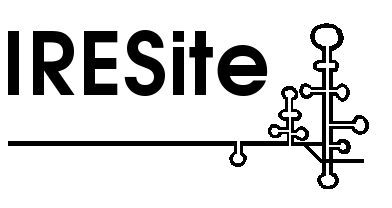Remarks:
Based on EST data the transcription start site of FeLV is quite exact (blastn query finds sequences starting
at same or almost same location with well aligning region 28-457 of this spliced mRNA sequence) so this mRNA
is complete at the 5'-end. The sequence of the cloned region for putative IRES activity was reverse-engineered
by Adam Lauring from the lab of J. Overbaugh because the original sequence files could not be used due to
technical issues. The genomes of closest strains of FeLV from the same lab are: M19392, M87886, M18246,
M89997. Based on the alignment of the FeLV-Notch2 partial sequence and of the genome of FeLV on can infer
regions contained in the subgenomic env-Notch2 message: M18247:341-545,5670-6046 (this is same Rohn et al.
(1996), Figure 5, FeLV/N2-B). Then positions 5370-7010 of Notch2 are included and then again retroviral
M18247:7716-. It is not clear where is the transcription termination site in the feline FeLV 3'-LTR region
and therefore this IRESite record includes complete 3'-LTR instead of just its leftmost part.
Part of the Notch2 CDS was appended to sequence of the cloned fragment based on a consensus sequence
derived easily from GenBank records (submitted from the lab of J. Overbaugh during the past): U47642, U47643,
U47644, U47645 differing in a few nucleotides each. The record U47644 spans most into the 3'-end and is
actually referred to in Lauring et al. (2000) in "Plasmid construction and Transfections".
The CDS region of Notch2 within this mRNA contains (although more than 1600 aa residues are missing on its
left and the total translation product in human is 2472 aa residues!). The FeLV-Notch2 fusion is not complete
either on its C-terminus but instead fused to the sequence of env CDS again. The next sequence shows where
is the first initiator methionine:
SKVFLEIDNRQCVQDSDQCFKNTDAAAALLASHAIQGTLSYPLVSVVSESLTRKGTQLLYLLAVAVVIILFIILLGVIMAKRKRKHGSLWLPEGFTLRRDSSNHKRREP
VGQDAVGLKNLSVQVSEANLIGSGTSEHWVDDEGPQPKKAKAENEALLSEEDDAIDRRPWTQQHLEAADIRRTPSLALTPPQAEQEVNVLDVNVRGPDGCTPLMLASLR
GGSSDISDEDKDREDSSANIITDLVYQGASLQAQTDRTGEMALHLAARYSRADAAKRLLDAGADANAQDNMGRCPLHAAVAADAQGVFQILIRNRVTDLDARMNDGTTP
LILAARLAVEGMVAELINCQADVNAVDDHGKSALHWAAAVNNVEATLLLLKNGANRDMQDNKEETPLFLAAREGSYEAAKILLDHFANRDITDHMDRLPRDVARDRMHH
DIVRLLDEYNVTPSPPGTVLTSALSPVICGPNRSFLSLKHTPMGKKPRRPNTKSAMPTSLPNLAKEAKDAKGSRRKKSLSDKGQLSESSVTLSPVDSLESPHTYVSDTTS
but here the putative translation product can start at the nearest in-frame AUG codon, thus the ORF is
817-2313 with translation product (the sequence in lowercase originates from C-terminus of FeLV env gene):
MAKRKRKHGSLWLPEGFTLRRDSSNHKRREP
VGQDAVGLKNLSVQVSEANLIGSGTSEHWVDDEGPQPKKAKAENEALLSEEDDAIDRRPWTQQHLEAADIRRTPSLALTPPQAEQEVNVLDVNVRGPDGCTPLMLASLR
GGSSDISDEDKDREDSSANIITDLVYQGASLQAQTDRTGEMALHLAARYSRADAAKRLLDAGADANAQDNMGRCPLHAAVAADAQGVFQILIRNRVTDLDARMNDGTTP
LILAARLAVEGMVAELINCQADVNAVDDHGKSALHWAAAVNNVEATLLLLKNGANRDMQDNKEETPLFLAAREGSYEAAKILLDHFANRDITDHMDRLPRDVARDRMHH
DIVRLLDEYNVTPSPPGTVLTSALSPVICGPNRSFLSLKHTPMGKKPRRPNTKSAMPTSLPNLAKEAKDAKGSRRKKSLSDKGQLSESSVTLSPVDSLESPHTYVSDTTS
pvplvynpnflhygpltnptpnsplrpmhp*
The record U47644 contains Notch2 fragment. The downstream bases were shown in Rohn et al, 1996 in Figure 5
and thus were inferred from M18247.
However, according to the original article the Notch2-ICD protein is being expressed in vivo and thought to be
expressed from this spliced envelope-like mRNA via IRES (the Notch2 sequence replaced most of the env gene
and therefore only a short, 72bp long uORF exists in the 814 bp long 5'-UTR region as a remnant of the
original env gene).
The integrity of the transcripts was assessed by RT-PCR (Rohn et al., 1996), S1 nuclease protection (Lauring
et al., 2000, Figure 1B), Northern blot (Lauring et al., 2000, Supplemental Figure 1).
|

